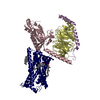+ データを開く
データを開く
- 基本情報
基本情報
| 登録情報 | データベース: PDB / ID: 7xbw | ||||||||||||
|---|---|---|---|---|---|---|---|---|---|---|---|---|---|
| タイトル | Cryo-EM structure of the human chemokine receptor CX3CR1 in complex with Gi1 | ||||||||||||
 要素 要素 |
| ||||||||||||
 キーワード キーワード | SIGNALING PROTEIN / G protein-coupled receptor / chemokine receptor / CX3CR1 | ||||||||||||
| 機能・相同性 |  機能・相同性情報 機能・相同性情報C-X3-C chemokine receptor activity / dendritic tree / multiple spine synapse organization, single dendrite / negative regulation of microglial cell mediated cytotoxicity / macropinosome membrane / C-X3-C chemokine binding / regulation of microglial cell migration / CX3C chemokine receptor binding / negative regulation of hippocampal neuron apoptotic process / microglial cell activation involved in immune response ...C-X3-C chemokine receptor activity / dendritic tree / multiple spine synapse organization, single dendrite / negative regulation of microglial cell mediated cytotoxicity / macropinosome membrane / C-X3-C chemokine binding / regulation of microglial cell migration / CX3C chemokine receptor binding / negative regulation of hippocampal neuron apoptotic process / microglial cell activation involved in immune response / host-mediated regulation of intestinal microbiota composition / autocrine signaling / synapse pruning / central nervous system maturation / positive regulation of microglial cell migration / synapse maturation / antifungal innate immune response / chemokine receptor activity / positive regulation of I-kappaB phosphorylation / C-C chemokine receptor activity / leukocyte tethering or rolling / C-C chemokine binding / regulation of tumor necrosis factor production / G protein-coupled peptide receptor activity / positive regulation of monocyte chemotaxis / leukocyte chemotaxis / regulation of nitric oxide biosynthetic process / Chemokine receptors bind chemokines / positive regulation of neurogenesis / negative regulation of interleukin-1 beta production / positive regulation of neuroblast proliferation / RSV-host interactions / neuronal cell body membrane / Respiratory syncytial virus (RSV) attachment and entry / social behavior / negative regulation of apoptotic signaling pathway / regulation of neurogenesis / negative regulation of long-term synaptic potentiation / T cell migration / D2 dopamine receptor binding / Adenylate cyclase inhibitory pathway / positive regulation of protein localization to cell cortex / cellular defense response / regulation of cAMP-mediated signaling / G protein-coupled serotonin receptor binding / cellular response to forskolin / cellular response to transforming growth factor beta stimulus / regulation of mitotic spindle organization / adenylate cyclase-inhibiting G protein-coupled receptor signaling pathway / G-protein beta/gamma-subunit complex binding / cell chemotaxis / negative regulation of cell migration / response to ischemia / Regulation of insulin secretion / G protein-coupled receptor binding / G protein-coupled receptor activity / calcium-mediated signaling / brain development / modulation of chemical synaptic transmission / adenylate cyclase-modulating G protein-coupled receptor signaling pathway / Olfactory Signaling Pathway / Activation of the phototransduction cascade / regulation of synaptic plasticity / Prostacyclin signalling through prostacyclin receptor / G beta:gamma signalling through PLC beta / Presynaptic function of Kainate receptors / Thromboxane signalling through TP receptor / Glucagon signaling in metabolic regulation / G protein-coupled acetylcholine receptor signaling pathway / G-protein activation / Activation of G protein gated Potassium channels / Inhibition of voltage gated Ca2+ channels via Gbeta/gamma subunits / G beta:gamma signalling through CDC42 / memory / response to peptide hormone / Vasopressin regulates renal water homeostasis via Aquaporins / G beta:gamma signalling through BTK / ADP signalling through P2Y purinoceptor 12 / Synthesis, secretion, and inactivation of Glucagon-like Peptide-1 (GLP-1) / Glucagon-type ligand receptors / Sensory perception of sweet, bitter, and umami (glutamate) taste / response to wounding / photoreceptor disc membrane / G alpha (z) signalling events / Adrenaline,noradrenaline inhibits insulin secretion / Glucagon-like Peptide-1 (GLP1) regulates insulin secretion / ADORA2B mediated anti-inflammatory cytokines production / cellular response to catecholamine stimulus / sensory perception of taste / positive regulation of angiogenesis / ADP signalling through P2Y purinoceptor 1 / adenylate cyclase-activating dopamine receptor signaling pathway / G beta:gamma signalling through PI3Kgamma / GPER1 signaling / Cooperation of PDCL (PhLP1) and TRiC/CCT in G-protein beta folding / chemotaxis / GDP binding / cellular response to prostaglandin E stimulus / Inactivation, recovery and regulation of the phototransduction cascade / G-protein beta-subunit binding 類似検索 - 分子機能 | ||||||||||||
| 生物種 |  Homo sapiens (ヒト) Homo sapiens (ヒト) | ||||||||||||
| 手法 | 電子顕微鏡法 / 単粒子再構成法 / クライオ電子顕微鏡法 / 解像度: 2.8 Å | ||||||||||||
 データ登録者 データ登録者 | Lu, M. / Zhao, W. / Han, S. / Zhu, Y. / Wu, B. / Zhao, Q. | ||||||||||||
| 資金援助 |  中国, 3件 中国, 3件
| ||||||||||||
 引用 引用 |  ジャーナル: Sci Adv / 年: 2022 ジャーナル: Sci Adv / 年: 2022タイトル: Activation of the human chemokine receptor CX3CR1 regulated by cholesterol. 著者: Minmin Lu / Wenli Zhao / Shuo Han / Xiaowen Lin / Tingyu Xu / Qiuxiang Tan / Mu Wang / Cuiying Yi / Xiaojing Chu / Weibo Yang / Ya Zhu / Beili Wu / Qiang Zhao /  要旨: As the only member of the CX3C chemokine receptor subfamily, CX3CR1 binds to its sole endogenous ligand CX3CL1, which shows notable potential as a therapeutic target in atherosclerosis, cancer, and ...As the only member of the CX3C chemokine receptor subfamily, CX3CR1 binds to its sole endogenous ligand CX3CL1, which shows notable potential as a therapeutic target in atherosclerosis, cancer, and neuropathy. However, the drug development of CX3CR1 is hampered partially by the lack of structural information. Here, we present two cryo-electron microscopy structures of CX3CR1-G complexes in ligand-free and CX3CL1-bound states at 2.8- and 3.4-Å resolution, respectively. Together with functional data, the structures reveal the key factors that govern the recognition of CX3CL1 by both CX3CR1 and US28. A much smaller conformational change of helix VI upon activation than previously solved class A GPCR-G complex structures is observed in CX3CR1, which may correlate with three cholesterol molecules that play essential roles in conformation stabilization and signaling transduction. Thus, our data deepen the understanding of cholesterol modulation in GPCR (G protein-coupled receptor) signaling and provide insights into the diversity of G protein coupling. | ||||||||||||
| 履歴 |
|
- 構造の表示
構造の表示
| 構造ビューア | 分子:  Molmil Molmil Jmol/JSmol Jmol/JSmol |
|---|
- ダウンロードとリンク
ダウンロードとリンク
- ダウンロード
ダウンロード
| PDBx/mmCIF形式 |  7xbw.cif.gz 7xbw.cif.gz | 174.2 KB | 表示 |  PDBx/mmCIF形式 PDBx/mmCIF形式 |
|---|---|---|---|---|
| PDB形式 |  pdb7xbw.ent.gz pdb7xbw.ent.gz | 126.1 KB | 表示 |  PDB形式 PDB形式 |
| PDBx/mmJSON形式 |  7xbw.json.gz 7xbw.json.gz | ツリー表示 |  PDBx/mmJSON形式 PDBx/mmJSON形式 | |
| その他 |  その他のダウンロード その他のダウンロード |
-検証レポート
| 文書・要旨 |  7xbw_validation.pdf.gz 7xbw_validation.pdf.gz | 1.3 MB | 表示 |  wwPDB検証レポート wwPDB検証レポート |
|---|---|---|---|---|
| 文書・詳細版 |  7xbw_full_validation.pdf.gz 7xbw_full_validation.pdf.gz | 1.3 MB | 表示 | |
| XML形式データ |  7xbw_validation.xml.gz 7xbw_validation.xml.gz | 35.6 KB | 表示 | |
| CIF形式データ |  7xbw_validation.cif.gz 7xbw_validation.cif.gz | 51.5 KB | 表示 | |
| アーカイブディレクトリ |  https://data.pdbj.org/pub/pdb/validation_reports/xb/7xbw https://data.pdbj.org/pub/pdb/validation_reports/xb/7xbw ftp://data.pdbj.org/pub/pdb/validation_reports/xb/7xbw ftp://data.pdbj.org/pub/pdb/validation_reports/xb/7xbw | HTTPS FTP |
-関連構造データ
| 関連構造データ |  33107MC  7xbxC M: このデータのモデリングに利用したマップデータ C: 同じ文献を引用 ( |
|---|---|
| 類似構造データ | 類似検索 - 機能・相同性  F&H 検索 F&H 検索 |
- リンク
リンク
- 集合体
集合体
| 登録構造単位 | 
|
|---|---|
| 1 |
|
- 要素
要素
| #1: タンパク質 | 分子量: 40447.141 Da / 分子数: 1 / 変異: S47C,G202T,G203A,E245A,A326S / 由来タイプ: 組換発現 / 由来: (組換発現)  Homo sapiens (ヒト) / 遺伝子: GNAI1 Homo sapiens (ヒト) / 遺伝子: GNAI1発現宿主:  参照: UniProt: P63096 | ||||
|---|---|---|---|---|---|
| #2: タンパク質 | 分子量: 38245.805 Da / 分子数: 1 / 由来タイプ: 組換発現 / 由来: (組換発現)  Homo sapiens (ヒト) / 遺伝子: GNB1 Homo sapiens (ヒト) / 遺伝子: GNB1発現宿主:  参照: UniProt: P62873 | ||||
| #3: タンパク質 | 分子量: 7861.143 Da / 分子数: 1 / 由来タイプ: 組換発現 / 由来: (組換発現)  Homo sapiens (ヒト) / 遺伝子: GNG2 Homo sapiens (ヒト) / 遺伝子: GNG2発現宿主:  参照: UniProt: P59768 | ||||
| #4: タンパク質 | 分子量: 41072.680 Da / 分子数: 1 / 変異: I120L, C221S, M250V / 由来タイプ: 組換発現 / 由来: (組換発現)  Homo sapiens (ヒト) / 遺伝子: CX3CR1, CMKBRL1, GPR13 Homo sapiens (ヒト) / 遺伝子: CX3CR1, CMKBRL1, GPR13発現宿主:  参照: UniProt: P49238 | ||||
| #5: 化合物 | | 研究の焦点であるリガンドがあるか | N | Has protein modification | Y | |
-実験情報
-実験
| 実験 | 手法: 電子顕微鏡法 |
|---|---|
| EM実験 | 試料の集合状態: PARTICLE / 3次元再構成法: 単粒子再構成法 |
- 試料調製
試料調製
| 構成要素 | 名称: Chemokine receptor CX3CR1 in complex with Gi1 / タイプ: COMPLEX / Entity ID: #1-#4 / 由来: RECOMBINANT |
|---|---|
| 由来(天然) | 生物種:  Homo sapiens (ヒト) Homo sapiens (ヒト) |
| 由来(組換発現) | 生物種:  |
| 緩衝液 | pH: 7.5 |
| 試料 | 包埋: NO / シャドウイング: NO / 染色: NO / 凍結: YES |
| 急速凍結 | 凍結剤: ETHANE |
- 電子顕微鏡撮影
電子顕微鏡撮影
| 実験機器 |  モデル: Titan Krios / 画像提供: FEI Company |
|---|---|
| 顕微鏡 | モデル: FEI TITAN KRIOS |
| 電子銃 | 電子線源:  FIELD EMISSION GUN / 加速電圧: 300 kV / 照射モード: SPOT SCAN FIELD EMISSION GUN / 加速電圧: 300 kV / 照射モード: SPOT SCAN |
| 電子レンズ | モード: BRIGHT FIELD / 最大 デフォーカス(公称値): 1500 nm / 最小 デフォーカス(公称値): 800 nm |
| 撮影 | 電子線照射量: 2.1875 e/Å2 フィルム・検出器のモデル: GATAN K3 BIOQUANTUM (6k x 4k) |
- 解析
解析
| ソフトウェア |
| ||||||||||||||||||||||||
|---|---|---|---|---|---|---|---|---|---|---|---|---|---|---|---|---|---|---|---|---|---|---|---|---|---|
| CTF補正 | タイプ: NONE | ||||||||||||||||||||||||
| 3次元再構成 | 解像度: 2.8 Å / 解像度の算出法: FSC 0.143 CUT-OFF / 粒子像の数: 702722 / 対称性のタイプ: POINT | ||||||||||||||||||||||||
| 精密化 | 交差検証法: NONE 立体化学のターゲット値: GeoStd + Monomer Library + CDL v1.2 | ||||||||||||||||||||||||
| 原子変位パラメータ | Biso mean: 52.17 Å2 | ||||||||||||||||||||||||
| 拘束条件 |
|
 ムービー
ムービー コントローラー
コントローラー




 PDBj
PDBj
































